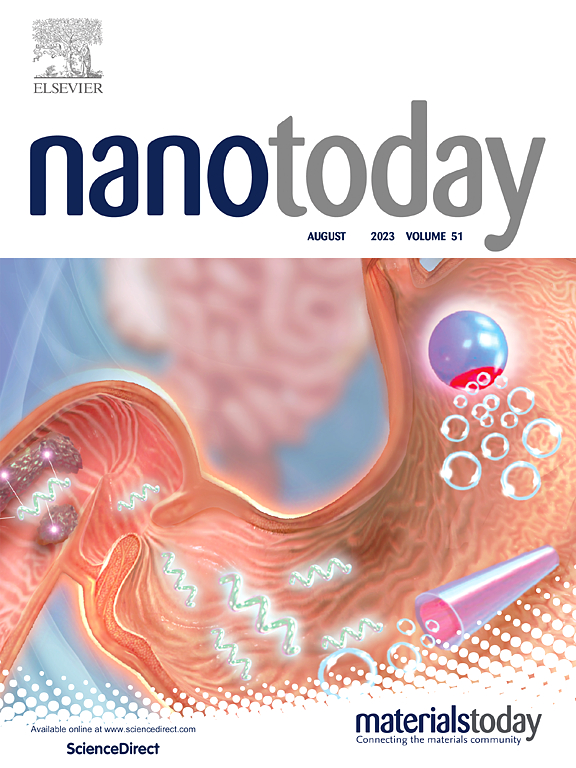自级联 ROS 捕获生物反应系统逆转干细胞氧化应激命运,促进骨生成
IF 13.2
1区 材料科学
Q1 CHEMISTRY, MULTIDISCIPLINARY
引用次数: 0
摘要
清除活性氧(ROS)对牙周再生至关重要。然而,应用材料在富含 ROS 环境中的动态变化以及宿主体内残留的氧化产物对牙周再生有很大影响。本研究利用谷胱甘肽(GSH)对 ROS 的高亲和力将过量的 ROS 吸引到交联点,通过硫醇-烯点击化学成功构建了一个生物反应系统。过氧化氢(H2O2)处理两分钟后,G8-0 水凝胶中的 ROS 水平会急剧下降,在 10 分钟内降至 4.4%,从而证实了 ROS 的捕获功效。通过 "诱饵切换 "机制,六方氮化硼(hBN)接管了捕获的 ROS,果胶的氧化产物进一步推动了还原反应,最终恢复了细胞外环境。自级联产物--氧化的 hBN 重塑了细胞内的氧化应激(OS)环境,实现了细胞内外的协同处理。G8-10 水凝胶中还原型谷胱甘肽与氧化型谷胱甘肽(GSH/GSSG)的比率明显较高(80%),说明骨髓干细胞(BMSCs)中的氧化应激得到了逆转。在分子水平上,生物反应系统抑制了 NF-κB 通路,促进了关键抗氧化基因(Nqo1 和 Nrf2)和成骨分子(ALP 和 OCN)的表达,从而逆转了 OS 对骨髓干细胞的有害影响。体内应用证明了该系统在牙周炎症环境中强大的氧化还原平衡和成骨能力。这种新型抗氧化生物反应系统具有自级联捕获 ROS 和利用产物的特点,为 OS 过多条件下的组织再生提供了创新的治疗策略。本文章由计算机程序翻译,如有差异,请以英文原文为准。
Self-cascade ROS-trapping bioreaction system reverses stem cell oxidative stress fate for osteogenesis
Reactive oxygen species (ROS) scavenging is essential for periodontal regeneration. However, the dynamic change of the applied materials within the ROS-rich environment and the residual oxidation products in the host highly impact periodontal regeneration. This study successfully constructs a bioreaction system via thiol-ene click chemistry, leveraging the high affinity of glutathione (GSH) for ROS to attract excess ROS to the crosslinking points. Two minutes after hydrogen peroxide (H2O2) treatment, the ROS level in the G8–0 hydrogel acutely decreases, reaching a 4.4 % reduction within 10 minutes, confirming the ROS-trapping efficacy. Through a ‘bait switch-on’ mechanism, hexagonal boron nitride (hBN) takes over the captured ROS and the oxidation products of pectin further drive the reduction reaction, ultimately restoring the extracellular environment. The self-cascade products, oxidized hBN, reshape the intracellular oxidative stress (OS) environment, achieving a synergistic extra- and intra-cellular treatment. The significantly high reduced to oxidized glutathione (GSH/GSSG) ratio in G8–10 hydrogel (∼80 %) illustrates a reversal of oxidative stress in bone marrow stem cells (BMSCs). On a molecular level, the bioreaction system inhibits the NF-κB pathway, promoting the expression of key antioxidant genes (Nqo1 and Nrf2) and osteogenic molecules (ALP and OCN), thereby reversing the detrimental effects of OS on BMSCs. In vivo application demonstrated the system’s strong redox-balancing and osteogenic capabilities in the periodontal inflammation environment. This novel antioxidant bioreaction system, characterized by self-cascade ROS-trapping and product utilization, offers innovative treatment strategies for tissue regeneration under conditions of excessive OS.
求助全文
通过发布文献求助,成功后即可免费获取论文全文。
去求助
来源期刊

Nano Today
工程技术-材料科学:综合
CiteScore
21.50
自引率
3.40%
发文量
305
审稿时长
40 days
期刊介绍:
Nano Today is a journal dedicated to publishing influential and innovative work in the field of nanoscience and technology. It covers a wide range of subject areas including biomaterials, materials chemistry, materials science, chemistry, bioengineering, biochemistry, genetics and molecular biology, engineering, and nanotechnology. The journal considers articles that inform readers about the latest research, breakthroughs, and topical issues in these fields. It provides comprehensive coverage through a mixture of peer-reviewed articles, research news, and information on key developments. Nano Today is abstracted and indexed in Science Citation Index, Ei Compendex, Embase, Scopus, and INSPEC.
 求助内容:
求助内容: 应助结果提醒方式:
应助结果提醒方式:


